Swiss Earnings Structure Survey (ESS) 2020
In 2020, the median wage of a full-time job in the Swiss economy as a whole (private and public sector) was CHF 6665 gross per month. The 10% of employees with the lowest wages earned less than 4382 francs per month, while the best-paid 10% received over 11,996 francs.
Between 2008 and 2020, the differences between the top and bottom of the wage pyramid remained stable overall. Wages in Switzerland continue to vary significantly by industry and region. More than one-third of employees (36.3%) receive bonuses and one in ten (10.5%) earns a low wage. This is according to the first results of the Swiss Wage Structure Survey 2020 of the Federal Statistical Office (FSO).
Large wage differences depending on the industry
In Switzerland, large wage differences were observed in 2020 depending on the industry. Wages in industries with high value added, such as information technology (9206 Swiss francs), pharmaceuticals (10 040 Swiss francs) and banking (10 211 Swiss francs), were significantly above the median wage (6665 Swiss francs gross per month).
In the middle of the scale were industries such as land transport (6310 francs), health (6821 francs), machinery (7141 francs) and wholesale trade (7145 francs). At the bottom of the wage pyramid were retail trade (4997 francs), hospitality (4479 francs), accommodation (4488 francs) and personal services (4211 francs).
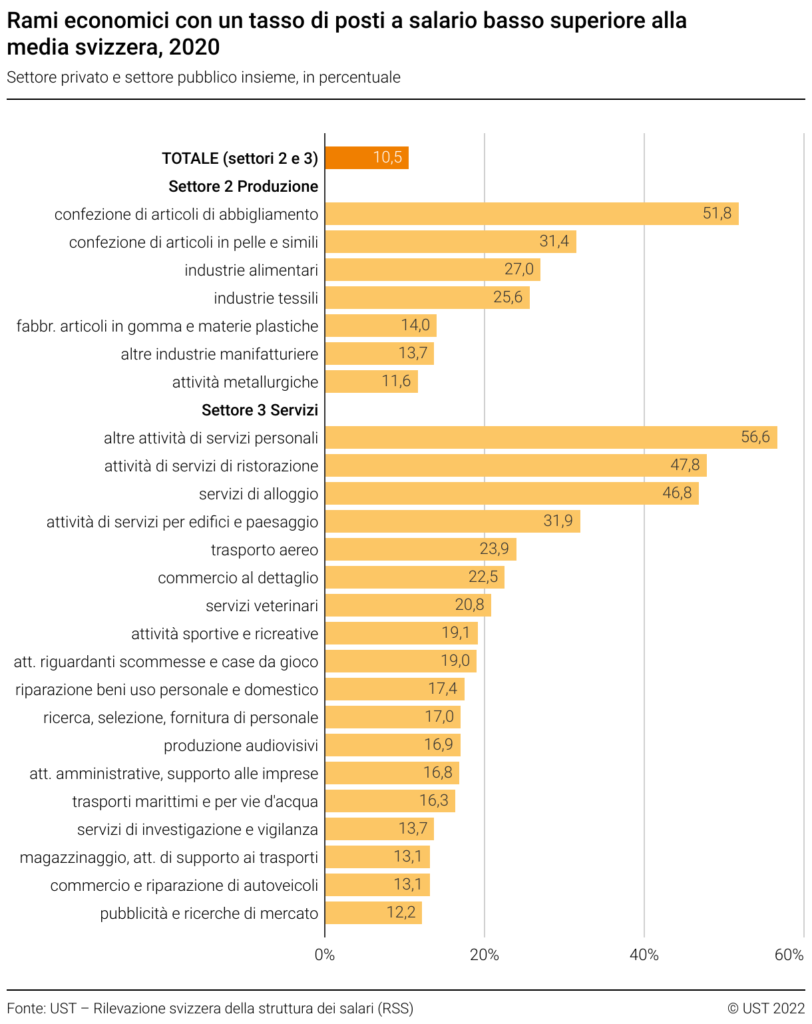
Economic sectors with more low-wage jobs than the Swiss average, 2020 ©UST
The wage gap has remained relatively stable between 2008 and 2020
The overall wage gap, i.e., the total gap between the highest and lowest wages, barely changed between 2008 and 2020 in the economy as a whole. During this period, wages for the highest-paid 10% of workers increased by 11.8%. Wage growth was lowest in the middle class, at 9.3%, while wages increased by 11.6% for the lowest-paid 10% of employees.
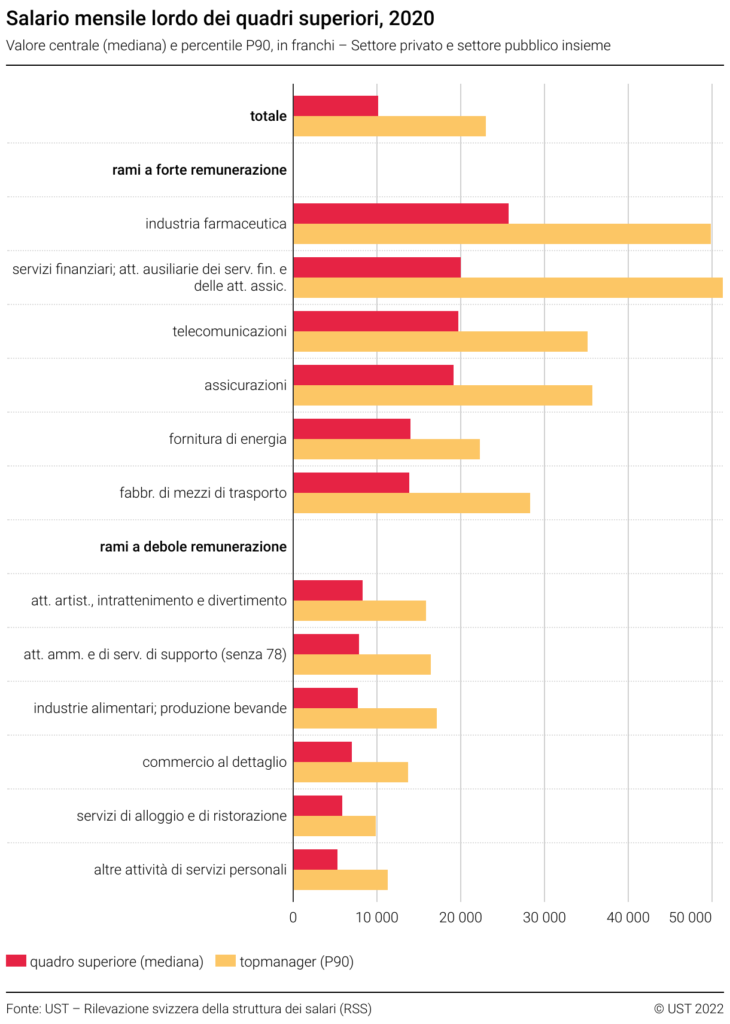
Bonuses increased further in 2020
In 2020, more than one-third (36.3% vs. 32.8% in 2018) of employees received a bonus, i.e. an irregular annual special payment paid in addition to the basic salary. On average, annual bonuses worth 10,142 francs were paid out (compared to 9913 francs in 2018).
The amount of bonuses varied significantly depending on the sector of the economy and the level of responsibility in the company. Senior management was paid an average of 4617 francs in public administration, 23,097 francs in retail, 90,264 francs in pharmaceuticals, 127,329 francs in financial services and 134,381 francs in banking.
Individuals without management responsibility also received bonuses. However, these were significantly lower at an average of 3998 francs per year. In most sectors of the economy, bonuses are a flexible but fixed component of the compensation system.
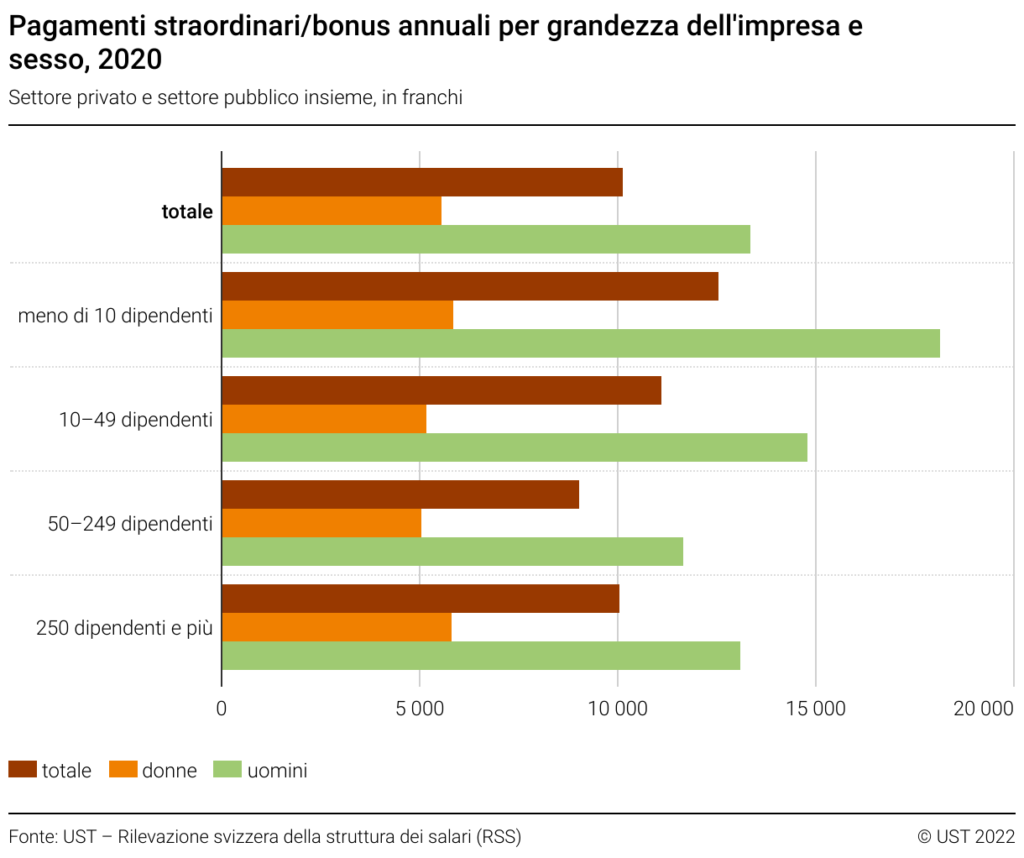
The share of low-wage jobs remains unchanged
A low-wage job in 2020 corresponded to a payment of less than 4443 francs gross per month for a full-time job. The number of low-wage jobs in Switzerland remained almost unchanged between 2018 and 2020 (decrease from 10.6% to 10.5%). The following economic sectors record a high share of low-wage jobs: Retail trade (22.5%), leather, leather goods, and footwear (31.4%), and hotels and restaurants (47.8%). In 2020, nearly half a million workers (491,900; 2018: 480,300) occupied a low-wage job. 63.5% of them were women.
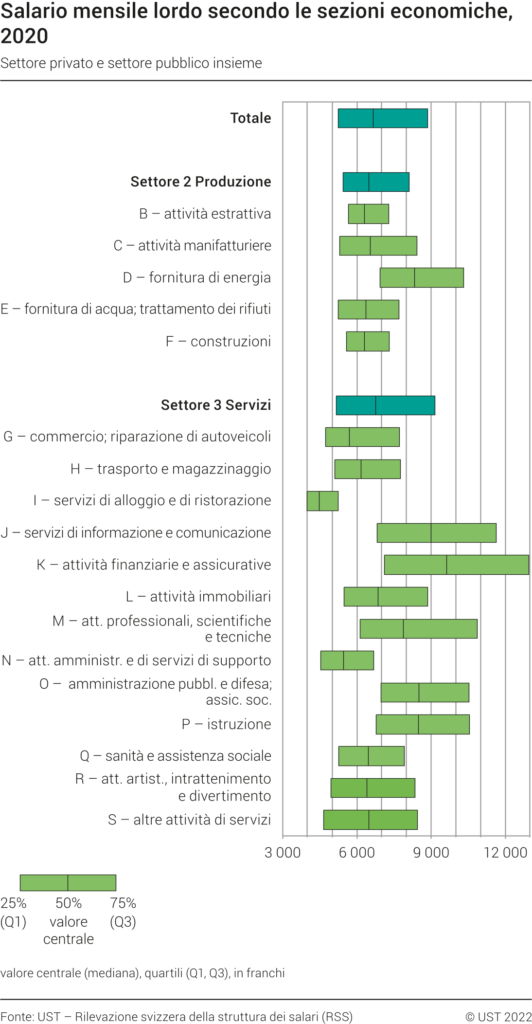
Gross monthly salary by economic section 2020 ©UST
Inequalities between women and men gradually decreasing
In the economy as a whole, the wage gap (median) between women and men is gradually narrowing. In 2020, it amounted to 10.8%, down from 11.5% in 2018 and 12.0% in 2016. These gender wage gaps can be partly explained by structural characteristics and differences in occupations (in particular, level of responsibility at work or sector of activity).
These wage differences reflect the unequal occupational integration of women and men in the labor market. The higher the hierarchical level of the job, the larger the gender pay gap. For example, women in jobs with a high level of responsibility earned 9249 francs gross per month, while men at the same level received 11,116 francs, a difference of 16.8% (2018: 18.6%).
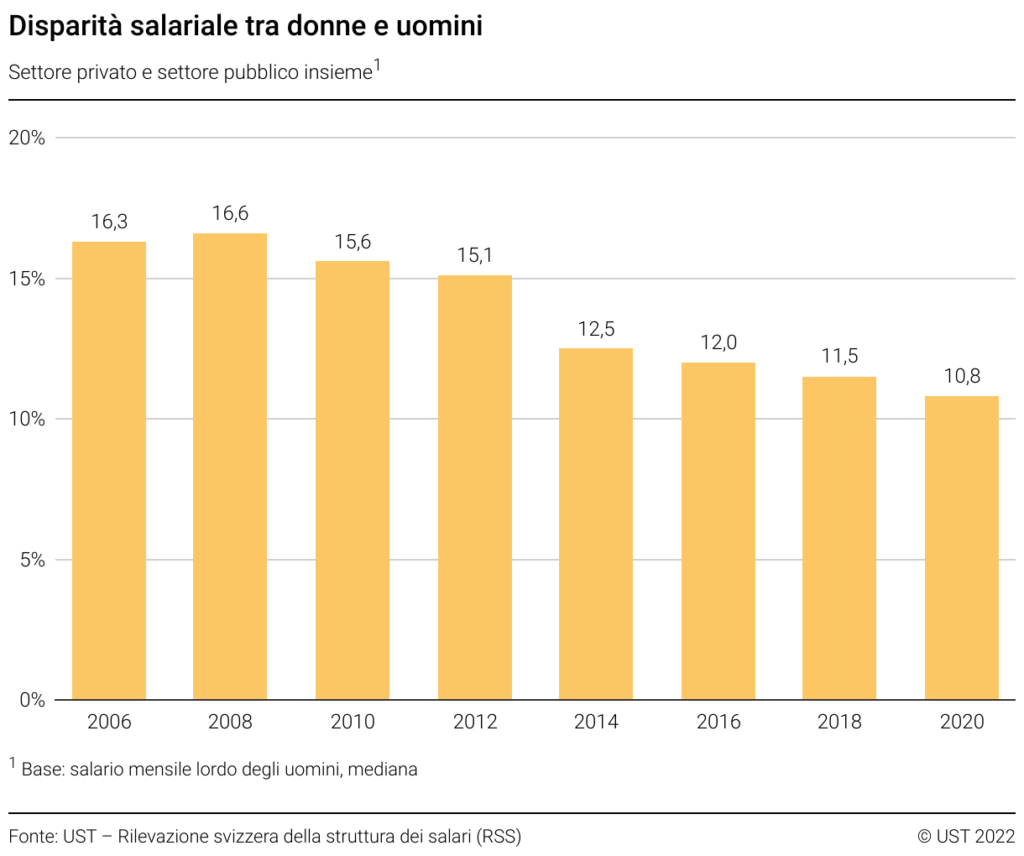
For jobs with lower levels of responsibility, the pay gap was less pronounced to the disadvantage of women at 9.3% (2018: 9.4%); for women without management functions, it amounted to 6.9% (2018: 7.6%). In 2020, the distribution of women and men by salary class was as follows: For jobs with a gross monthly salary of less than 4500 francs, the share of women was 58.0% (compared to 58.3% in 2018). In contrast, 80.2% of jobs with a gross monthly wage of more than 16,000 francs were held by men (2018: 82.4%).
Foreign employees: Differences according to residence status
In the economy as a whole, the wages of employees with Swiss citizenship were higher than those of foreign employees (6988 francs versus 6029 francs). For jobs requiring a high degree of responsibility, however, the wages of foreign employees were generally higher than those of Swiss employees. For example, cross-border commuters in senior management positions received 10,692 francs, persons with a residence permit 12,268 francs and Swiss nationals 10,346 francs.
For jobs without management responsibility, the situation was reversed: Swiss employees without a management function earned an average of 6345 francs and thus more than foreign employees with cross-border commuter status (5773 francs) and those with a residence permit (5287 francs).
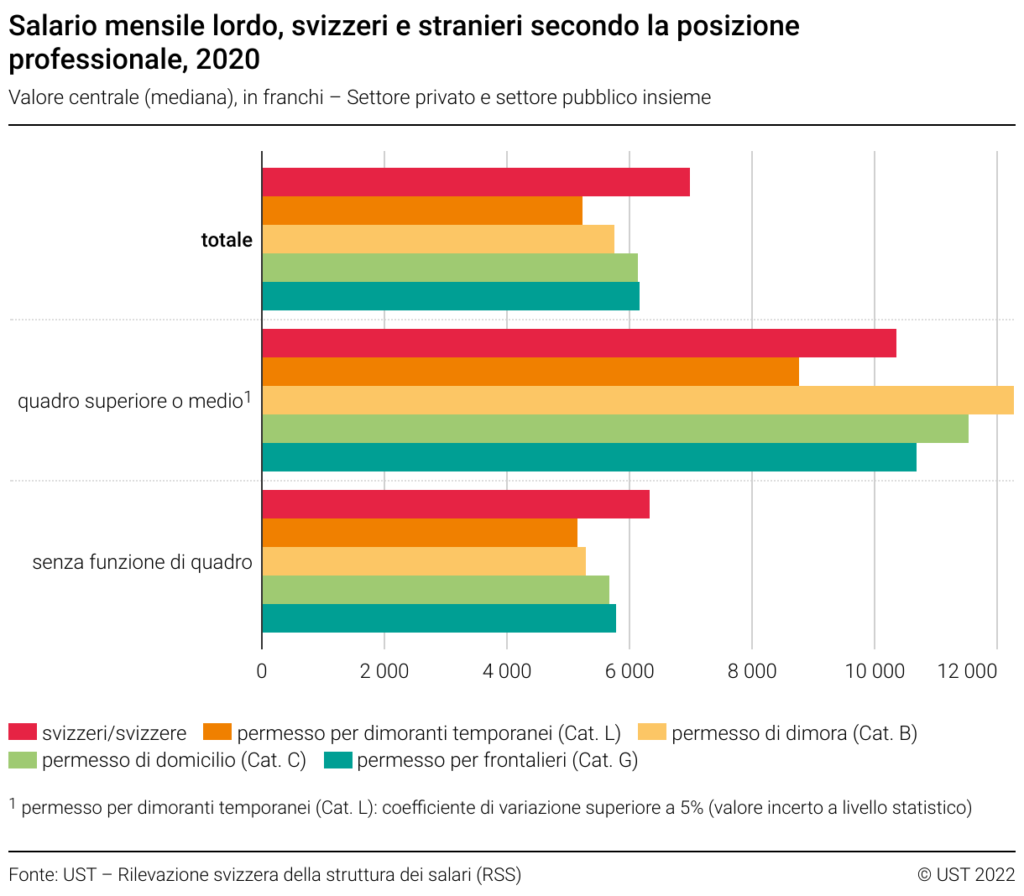
Wages in the regions: Zurich remains at the top
Swiss wages also vary significantly between regions. Salaries for upper management are regularly highest in Zurich (11,475 francs) and the Lake Geneva region (11,200 francs). Ticino is at the lower end of the wage scale, with 8537 francs for upper management jobs and 5137 francs for non-management jobs, regardless of hierarchy level. These regional wage differences can be explained by the spatial concentration of industries with high value added and by structural features of regional labor markets.
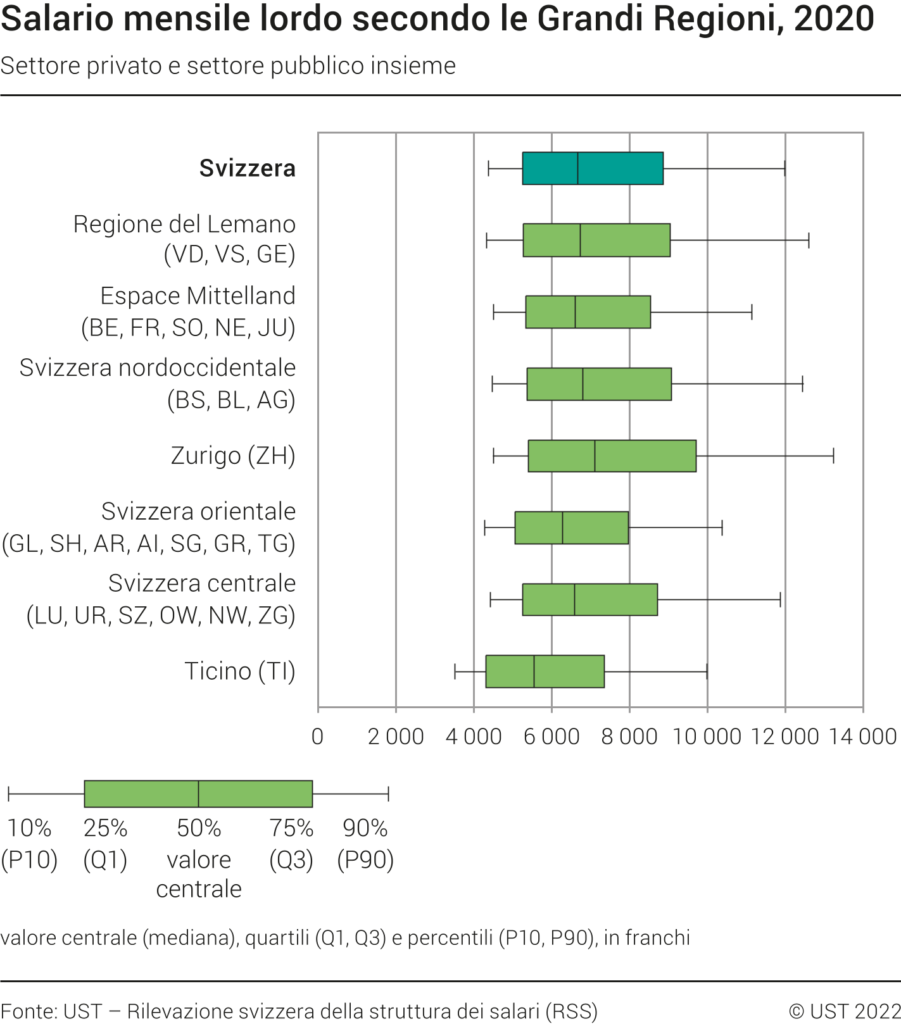
Source: https://www.bfs.admin.ch/bfs/it/home/attualita/comunicati-stampa.html





